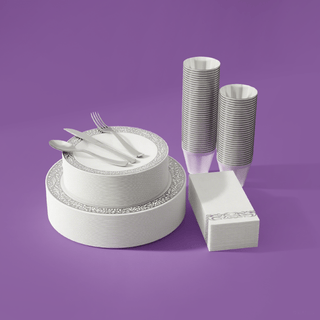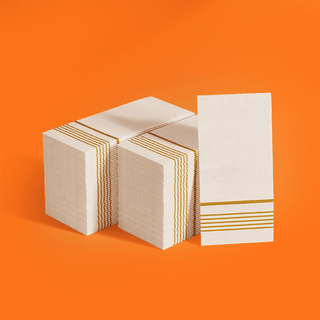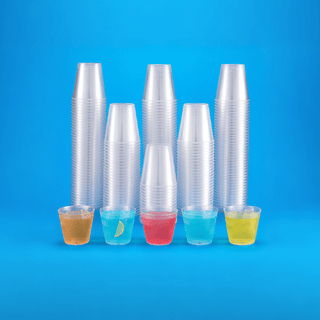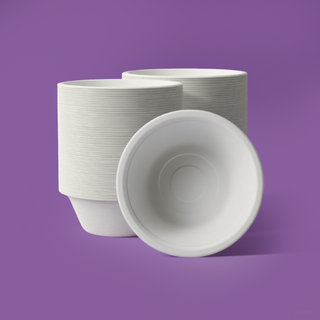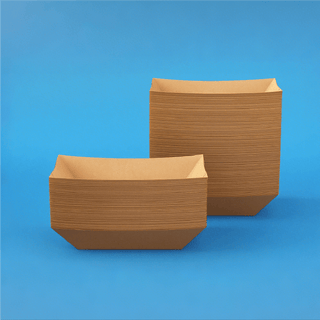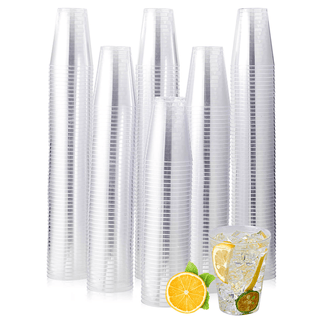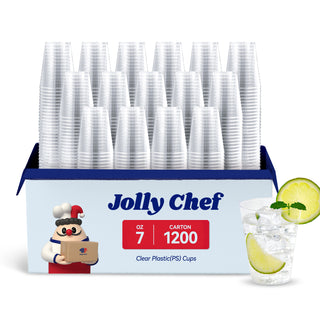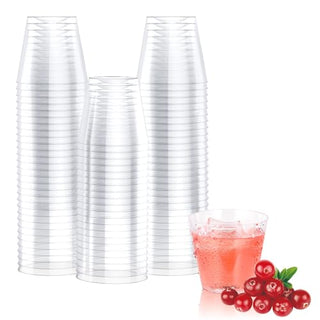
No Matter How Cheap They Are, Never Buy These 3 Types of Plastic Cups—Especially the Third One
Introduction
Plastic cups are everywhere—whether you're grabbing a quick coffee or hosting a party. But here's the thing: not all plastic cups are safe or eco-friendly. Some could be hiding harmful chemicals, while others are designed with your health and the planet in mind. In this article, we'll break down the different types of plastic used in cups, point out the ones to avoid, and share the best options for a safer, greener choice. Trust us, knowing what to look for (and what to skip) can make all the difference.

What Are the Different Types of Plastic Materials Used in Plastic Cups?
Plastic cups come in all sorts of materials, each with its own perks. As the Precious Plastic Academy explains, plastics generally fall into two main categories: Thermoplastics and Thermosets.

Thermosets
Thermoset plastics are made from polymers that form permanent, unbreakable bonds—kind of like baking bread. Once it’s baked, you can’t just melt it back into dough; you’d just end up with burnt toast. Because of this irreversible structure, thermoset plastics can’t be recycled.
Thermoplastics
Thermoplastics are the kind of plastics that get soft when heated and harden when cooled—and you can do this over and over again. Heat them up, and they turn into a liquid; let them cool, and they solidify. It’s a lot like butter: melt it for cooking, and it firms back up in the fridge. The cool part? About 80% of the world’s plastics are thermoplastics, which means they’re recyclable and can be reused.
These plastics come in different types, each with its own structure and properties. You can usually tell them apart by their name or a number stamped somewhere on the product—kind of like a secret code for what they’re made of.
Here are the most common thermoplastics used in plastic cups are:

PET (1): Polyethylene Terephthalate
PET is a tough and clear plastic that you’ve probably seen everywhere—think water bottles, soda bottles, jars, and even shopping bags. It’s also used in things like carpets and ropes. What’s cool about PET is that it’s one of the most recycled plastics out there. These days, it’s even getting a second life as yarn for clothing, turning old bottles into fresh new threads.
HDPE (2): High-Density Polyethylene
HDPE is a go-to plastic for everyday items like food containers, milk jugs, shampoo bottles, detergent containers, and even toys. It’s a favorite for recycling because it’s easy to collect, clean, and sort—making it a top choice for eco-friendly reuse.
PVC (3): Polyvinyl Chloride
PVC PVC is toxic and it is most commonly found in plumbing pipes and releases chloride when heated up.
LDPE (4): Low-Density Polyethylene
LDPE is what you’ll find in sandwich bags, squeeze bottles, and grocery bags. But recycling it? That’s tricky. Cleaning and sorting can be a hassle, so a lot of LDPE ends up in the trash.
PP (5): Polypropylene
PP is a widely available plastic known for its strength and resistance to higher temperatures. It is frequently used in food-related products like Tupperware, yogurt containers, and syrup bottles.
PS (6): Polystyrene
PS, or what most folks call Styrofoam, is everywhere—think disposable coffee cups, takeout containers, plastic forks, and packing peanuts. While it can technically be recycled, it’s a bit tricky, but it’s got that sleek, glass-like finish that can be buffed up to look pretty sharp.
MIX (7): Mixed Plastics
This category includes plastics such as ABS, acrylic, or polycarbonate, which are more challenging to recycle.
Among these thermoplastics, PP, PS, PET, and CPLA are the most commonly used materials for disposable cups. Each material has its distinct properties, offering various advantages depending on the cup’s intended use, whether for hot, cold, or eco-friendly options.
Which Plastic Materials Pose Health Risks and Their Hazardous Materials Classification?
Not all plastics are safe—some can actually be pretty sketchy when it comes to your health. Certain plastic cups, for example, might contain nasty chemicals that can mess with your well-being. Here’s a heads-up on the types you should steer clear of because of their potential risks:
Unlabeled Plastic Cups
When you're buying plastic cups, one of the biggest red flags is picking up a product without a clear label showing what kind of plastic it’s made of. No label? No way to tell if it’s packed with nasty stuff like BPA, phthalates, or other sketchy chemicals.
Contained Toxic Substances
Watch out for plastic cups that might leak nasty chemicals into your drinks. For instance, cups made from polystyrene or PVC can release stuff like styrene—especially when they get hot—which isn’t exactly great for your health.
BPA-Containing Plastic Cups
Bisphenol A (BPA) is a chemical found in certain plastics, like polycarbonate. Research has tied BPA to serious health concerns—think hormone imbalances, developmental issues, and even a higher risk of some cancers. If you’re using plastic cups for food or drinks, steer clear of anything with BPA. It’s just not worth the risk.

To wrap it up, it’s important to avoid plastic cups that aren’t labeled, since you won’t know what materials are in them. Stay away from cups made from polystyrene or PVC—these can release harmful chemicals into your drinks, especially when heated. And, most importantly, never use cups that contain Bisphenol A (BPA), which has been linked to hormone disruption and higher cancer risks. Always go for BPA-free options to keep yourself safe and healthy.
Which Types Of Plastic Materials Are Recommended for Purchase?
When shopping for plastic cups, it’s essential to choose materials that are both safe for your health and environmentally responsible. Here’s a closer look at some of the best options:
PP Plastic Cups
Advantages: Durability and Aesthetic Appeal
Polypropylene (PP) cups are known for being strong and heat-resistant. They’re less likely to crack or warp, even with heavy use. Plus, PP cups can be clear, giving your drinks a sleek, modern look. They’re also one of the safest plastic options around, since they’re less likely to leach harmful chemicals compared to other plastics.
PET Plastic Cups
Advantages: Clarity and Strength
PET cups are a go-to choice for cold drinks because they’re clear and strong. They’re durable, resistant to cracking, and give a premium feel to drinks like iced coffee, juice, and smoothies. Plus, they’re usually considered safer than other plastics since they’re BPA-free and don’t contain harmful chemicals.
PS Plastic Cups
Advantages: Cost-Effective and Versatile
Polystyrene is a popular and affordable option for disposable cups. While they’re best for cold drinks, they’re also lightweight and easy to use. For short-term needs, PS cups can be a practical and convenient choice.
CPLA Compostable Cups
Advantages: Eco-Friendly and Safe
CPLA is a great option if you’re looking for an eco-friendly and safe alternative. Made from renewable materials like cornstarch, CPLA cups are both compostable and biodegradable. They’re ideal for eco-conscious folks who want to cut down on their environmental impact while still using a non-toxic, safe cup material.
Conclusion: What to Buy and What to Avoid
In summary, when picking out plastic cups, it’s crucial to steer clear of certain materials that can be harmful to your health. First off, avoid unlabeled plastic cups—you never know what they’re made of, and that’s a risk you don’t want to take. Next, skip cups made from PVC, as they can leach nasty chemicals when heated. And most importantly, stay away from anything with Bisphenol A (BPA), a chemical tied to hormone issues and even cancer.
Instead, go for safer picks like polypropylene (PP), which is tough and handles heat like a champ, or polyethylene terephthalate (PET), a sturdy and clear option. Polystyrene (PS) works well for disposable cups, but keep it for cold drinks since it doesn’t hold up to heat. If you’re eco-minded, compostable CPLA cups made from stuff like cornstarch are a fantastic choice. Bottom line? Always go for BPA-free and planet-friendly materials—it’s a win for you and the environment.


